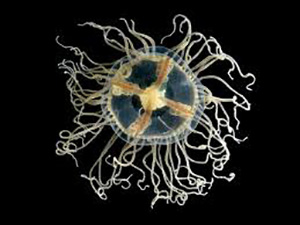Kortney’s Challenge fun run/walk raises funds for pediatric cancer
June 29, 2016West Long Branch Council briefs WLB calls vandalism ‘silly’ and ‘senseless’
June 29, 2016By Patty Booth O’Neill
They cling to eelgrass, live sparsely, are nocturnal, and indigenous to Japan.
That was then, this is now.

Clinging jellyfish are multiplying in the Shrewsbury and surrounding rivers with no apparent natural preditor.
“About three days ago I found about 50 jellyfish in one hour off my dock,” said Monmouth Beach resident Emily Sgro, who is currently a student at Sacred Heart University. “Today I caught 30 more in a half hour.”
The conditions she captured the jellyfish under seem to go against the common knowledge of their nature, that they are nocturnal, clingy and they should not be so pervasive. But Emily found them during the day floating freely in the Shrewsbury River. And she found a lot.
And their poisonous sting can be dangerous. One man was hospitalized after being stung last week while swimming off the river in Oceanport.
The abundance of clinging jellyfish in the Shrewsbury prompted Dr. Paul Bologna, Director, Aquatic and Coastal Sciences, Biology and Molecular Biology at Montclair State College, to visit Monmouth Beach on Tuesday morning to answer any questions about the invaders.
“Most likely if you get bit you will only experience severe muscle cramps,” he informed us. “It’s only the worst case scenario that someone will experience kidney failure.”
Clinging jellyfish, which are coin-sized and appear to have an “X” on their bodies, feed mainly on small fish and crustaceans. They paralyze them with their tentacles and pull them into their mouths.
“We don’t know of any natural predators right now,” Bologna said. “We are still in the early stages of our investigations.”
Deena Restaino, a graduate student who works with Dr. Bologna, spoke about turtles, a natural predator of jellyfish. “Turtles will not come into shallow waters so they won’t eat these particular ones,” she said.
Restaino said that the key to control any growth would be to find out where the polyps are and find a control mechanism for that.
Polyps are the second phase of development after larva. They cling to the riverbed and multiply undergoing asexual reproduction, so from one ferialized egg they can produce multiple jellyfish.
“These jellyfish are so small that so far we haven’t seen any effect they will have on the ecosystem,” Restaino said. “But as a whole, invasive species tend to have those effects.”
The team is going to take clippings of their tentacles to check their DNA against other populations to check for subtle differences.
“People think that because they’re from the Pacific that it will be too cold here, but not at all. They will be fine.”
Since clinging jellyfish are indigenous to Pacific waters off Japan it’s not known definitively how they made it to the Shrewsbury River. It’s most likely they were in the ballast of ships.
Restaino said if you are stung, don’t rinse with fresh water or alcohol, just vinegar.
“
The sting is very uncomfortable and the issues get ramped up the more individuals you come in contact with at a single time, Restaino said. “It is very painful and there is severe cramping, muscle pain, joint discomfort.”
Sgro said that she wasn’t afraid of continuing her water sports in the river; she just won’t go swimming. “I’ll continue with kayaking and jet skiing,” she said, “I’ll just make sure I won’t fall in.”
Some parents expressed their concerns about kids thinking it will be fun to go hunting for the poisonouss jellyfish. “This could be very dangerous, I hope it doesn’t turn into a trend,” one said.
Scientists do know that clinging jellyfish only like calm waters, so you won’t find them in the ocean.





